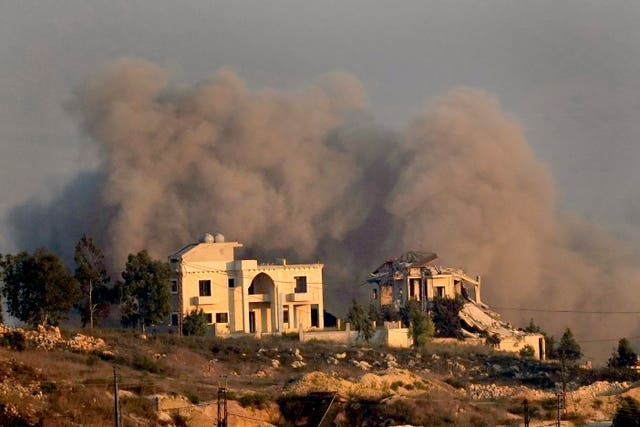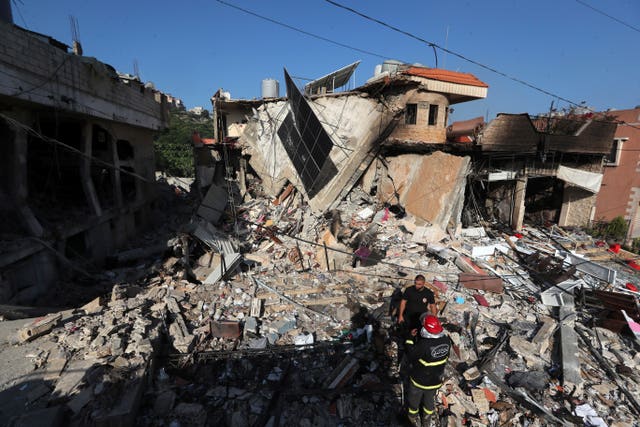Israel bombards Hezbollah, killing a top commander, while families flee Lebanon
The UN Security Council scheduled an emergency meeting on Lebanon for Wednesday at the request of France.

Israel killed a top Hezbollah commander on Tuesday as part of a two-day bombing campaign that has left more than 560 people dead and prompted thousands in southern Lebanon to seek refuge from the widening conflict.
With the two sides on the brink of all-out war, Hezbollah launched dozens of rockets into Israel on Tuesday, targeting an explosives factory and sending families into bomb shelters.
Families that fled southern Lebanon flocked to Beirut and the coastal city of Sidon, sleeping in schools turned into shelters, as well as in cars, parks and along the beach. Some sought to leave the country, causing a traffic jam at the border with Syria.
Israel said late on Tuesday that fighter jets carried out “extensive strikes” on Hezbollah weapons and rocket launchers across southern Lebanon and in the Bekaa region to the north.
Asked about the duration of Israel’s operations in Lebanon, military spokesman Rear Admiral Daniel Hagari said at a news conference that it aims to keep them “as short as possible, that’s why we’re attacking with great force”.
“At the same time, we must be prepared for it to take longer,” he said.
Israel has responded with increasingly heavy airstrikes and the targeted killing of Hezbollah commanders while threatening a wider operation.
The UN Security Council scheduled an emergency meeting on Lebanon for Wednesday at the request of France.
Israel said a strike in Beirut on Tuesday had killed Ibrahim Kobeisi, who it said was a top Hezbollah commander with the group’s rocket and missile unit.
Military officials said Kobeisi was responsible for launches towards Israel and planned a 2000 attack in which three Israeli soldiers were kidnapped and killed. Hezbollah later confirmed his death.
It was the latest in a string of assassinations and setbacks for Hezbollah, the strongest political and military actor in Lebanon and widely considered the top paramilitary force in the Arab world.
Lebanon’s Health Ministry said six people were killed and 15 were wounded in the strike in a southern Beirut suburb, an area where Hezbollah has a strong presence.
The country’s National News Agency said the attack destroyed three floors of a six-storey apartment building.
The UN’s high commissioner for refugees in Lebanon said one of its staffers and her young son were among those killed on Monday in the Bekaa region, while a cleaner under contract was killed in a strike in the south.

The renewed exchange came after Monday’s barrages racked up the highest death toll in any single day in Lebanon since Israel and Hezbollah fought a bruising monthlong war in 2006.
On Tuesday, mourners carried 11 bodies through the streets of the Lebanese village of Saksakieh, some 40 kilometres (25 miles) north of the Lebanon-Israel border, including those of four women, an infant and a seven-year-old girl. All were killed in Israel’s bombardment of the village on Monday.
Some of the bodies were draped in Hezbollah flags, others wrapped in black clothes. A wreath of flowers was placed on top of the smallest one.
Mohammad Halal, father of seven-year-old Joury Halal, said his daughter was an “innocent child martyr”.
“She is a martyr for the sake of the south and Palestine,” Mr Halal said and defiantly stated his allegiance to Hezbollah leader Hassan Nasrallah.
Israel said it targeted sites where Hezbollah had stored weapons. Data from American fire-tracking satellites analysed on Tuesday by The Associated Press showed the wide range of Israeli airstrikes aimed at southern Lebanon, covering an area of more than 1,700 square kilometres (650 square miles).
Nasa’s Fire Information for Resource Management System typically is used to track US wildfires, but can also be used to track the flashes and burning that follow airstrikes. Data from Monday showed significant fires across southern Lebanon and in the Bekaa Valley.
The Lebanese Health Ministry said at least 564 people have been killed in Israeli strikes since Monday, including 50 children and 94 women, and that more than 1,800 have been wounded — a staggering toll for a country still reeling from a deadly attack on communication devices last week.

Israel has vowed to do whatever it takes to ensure its citizens can return to their homes in the north, while Hezbollah has said it will keep up its rocket attacks until there is a cease-fire in Gaza, which appears increasingly remote.
The Israeli military says it has no immediate plans for a ground invasion but is prepared for one. It has moved thousands of troops who had been serving in Gaza to the northern border. It says Hezbollah has some 150,000 rockets and missiles, including some capable of striking anywhere in Israel, and that the group has fired some 9,000 rockets and drones since last October.
Israel said its warplanes struck 1,600 Hezbollah targets on Monday, destroying cruise missiles, long- and short-range rockets and attack drones, including weapons concealed in private homes.
Monday’s escalation came after a particularly heavy exchange of fire on Sunday, when Hezbollah launched around 150 rockets, missiles and drones into northern Israel.
Last week, thousands of communications devices used mainly by Hezbollah members exploded in different parts of Lebanon, killing 39 people and wounding nearly 3,000, many of them civilians. Lebanon blamed Israel, but Israel did not confirm or deny responsibility.





